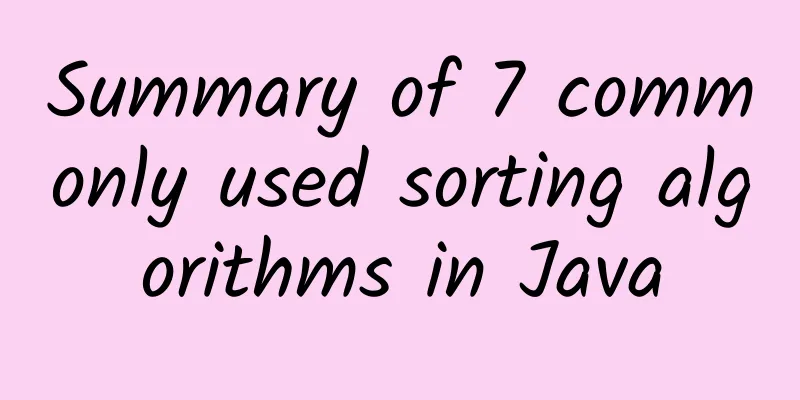Summary of 7 commonly used sorting algorithms in Java

|
I have been free for a while, so I took some time to summarize the seven commonly used sorting algorithms in Java. I hope I can review them later! 1. Insertion sort algorithm The basic idea of insertion sort is that in the process of traversing the array, it is assumed that the elements before serial number i, that is, [0..i-1], have been sorted. This trip needs to find the correct position k of the element x corresponding to i, and in the process of finding this position k, move the compared elements back one position one by one to "make room" for the element x, and finally assign the element value corresponding to k to x. In general, the time complexity and space complexity of insertion sort are O(n2) and O(1), respectively.
2. Selection sort algorithm The basic idea of selection sort is to traverse the array, with i representing the number that needs to be sorted, and then find the minimum value in the remaining [i…n-1], and then exchange the minimum value found with the value pointed to by i. Because there is a sub-process of selecting the highest value in each process of determining the element, people figuratively call it selection sort. The time complexity and space complexity of selection sort are O(n2) and O(1) respectively.
3. Bubble sort algorithm Bubble sort is to put larger numbers at the bottom and smaller numbers at the top.
4. Quick sort algorithm Through a sorting process, the records to be sorted are divided into two independent parts. The keywords of one part of the records are smaller than those of the other part. Then, the two parts of the records can be sorted separately to achieve the purpose of ordering the entire sequence. The essence is to find a base position (pivot, watershed, which is smaller than the left and larger than the right. It can be random and named base. First, start from the rightmost side of the sequence to find a smaller one than base. If it is smaller, change the position, so that the base moves to the position on the right just now (smaller than the base when compared) (recorded as a temporary high position), so that the right side of the base is larger than the base. Then, start from the leftmost side of the sequence to find a larger one than base. If it is larger, change the position, so that the base moves to the position on the left just now (larger than the base when compared) (recorded as a temporary low position), so that the left side of the base is smaller than the base. Repeat the above two steps until low == high, which makes the pivot and watershed truly found. Return to this position, and recurse on the sequences on the left and right of the watershed respectively.
5. Merge sort algorithm Merge sort is implemented recursively, which belongs to the "divide and conquer" method. The target array is divided into two from the middle, and then the two arrays are sorted separately. After the sorting is completed, the two sorted arrays are "merged" together. The most important thing about merge sort is the "merging" process. The merging process requires additional space that is the same length as the two arrays to be merged.
6. Shell sort algorithm Shell sort was born because insertion sort encounters the problem of moving too many elements when processing large-scale arrays. The idea of Shell sort is to "divide and conquer" a large array into several small arrays, divided by gap. For example, the array [1, 2, 3, 4, 5, 6, 7, 8], if divided by gap = 2, can be divided into two arrays [1, 3, 5, 7] and [2, 4, 6, 8] (correspondingly, if gap = 3, the divided arrays are: [1, 4, 7], [2, 5, 8], [3, 6]) and then insert sort the divided arrays separately. After each sub-array is sorted, reduce the gap value and repeat the previous steps until gap = 1, that is, insert sort the entire array. At this time, the array is basically sorted, so the elements that need to be moved will be very small, which solves the problem of a large number of moves when inserting sort is processing large arrays. Shell sort is an improved version of insertion sort. It is very helpful to improve efficiency when the amount of data is large. When the amount of data is small, it is recommended to use insertion sort directly.
7. Heap sort algorithm The essence is to first construct a big top heap, parent is larger than children, the root node is the *** node, swap the *** node (root) with the tail node (the *** node, which is smaller), leaving the *** tail node, now ***, and the rest, starting from the *** element to the position before the tail node, construct a big top heap recursively.
|
<<: Starting a business? Actually, I just don’t want to work.
>>: Mobile, Ecosystems, and the Death of the PC
Recommend
Professor Li Ming's "Self Psychology"
Course Description Psychoanalysis refers to a psy...
5 major brand communication routines: Analyzing the New Oriental annual meeting program screen-sweeping incident!
On January 25, Beijing New Oriental School’s annu...
6,000 clicks, 5 conversions? It’s this influencing factor that’s causing all the trouble!
Do you know what is the ultimate factor affecting...
2022 Veterans’ Academic Advancement Policy: What are the benefits?
Every soldier contributes his own part to the cons...
Li Ge's Kuaishou mini-game project: zero threshold and zero foundation, earning 600+ per day
A few days ago, I secretly led 30 people to work ...
A 4-year-old girl in Shanghai got lost on the beach! There are many dangers near the water that you would never imagine...
These days, the safety of the missing 4-year-old ...
It’s difficult to increase followers! How to scientifically and effectively increase the rate of followers of public accounts through pictures and texts?
《XXX gained 50,000 followers for one article》 &qu...
You have to wear a mask when you go out every day. Are you really wearing it correctly?
The weather is getting hotter. Do you always want...
Lao Duan talks about OTT: 8 common misunderstandings about Internet TV
Duan Youqiao, an artist of iQiyi. From an Interne...
With just a canoe, the coastal ancestors began to explore the sea!
Most coastal settlements in the Neolithic Age wer...
Why do we have more “black spots” on our bodies as we age? Does it have any impact on our health?
A friend told Huazi that as he grew older, he fou...
How do big companies like Tik Tok and Duoduo APP carry out promotion and marketing?
It is already the beginning of 2019, and the New ...
1 Gu Ailing = 100+ popular headlines?
The hot topic that marketers are paying attention...
Why do you keep getting acne? Which of these 20 reasons do you fall into?
A netizen asked: Teacher, please tell me how to a...
Wandering "Love Rival Strategy Video Course" + "Love Rival Handbook"
Introduction to the resources of Langji's &qu...









